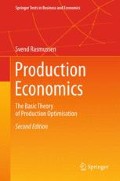Abstract
The general criteria for the adjustment of production when product and factor prices change were described in Chaps. 3, 4, and 5. The general results are derived under the general assumption that the producers wish to maximise profit. The general criterion for profit maximisation is that the addition of input should be continued as long as the increase in total revenue (i.e. marginal revenue) is greater than the increase in costs (i.e. marginal costs). This general criterion includes the following two criteria as special cases: (1) The value of the marginal product for all (variable) inputs must be equal to the price of the corresponding input (VMP i = w i ), and (2)The marginal costs must be equal to the price of output (MC = p y ).
Access this chapter
Tax calculation will be finalised at checkout
Purchases are for personal use only
Notes
- 1.
The Lagrange function is a well known mathematical tool used in economics. For further explanation see any advanced mathematical textbook or mathematical economics textbook such as Chiang (1984).
- 2.
Repeat the homothetic production function in Sect. 4.3.
- 3.
The example is naturally somewhat simplified. Hence, the possibility of the available land being used to grow other crops is not considered here. Also, please note that the model in Figs. 10.2 and 10.3 used for land in fact presupposes: (1) the existence of fixed input (e.g. labour) in addition to x 1 and x 2, or (2) that the quality of land declines with the increasing amount of acreage. Otherwise, there would be no profit maximum at A!
- 4.
For the sake of simplification, the meat production that is normally part of milk production is disregarded. Please refer to the original article which includes meat production.
- 5.
The reason why this is optimal is because a possible further reduction in production will not be motivated by the quota restriction but by a desire to achieve profit maximisation.
References
Chiang, A. C. (1984). Fundamental methods of mathematical economics (3rd ed.). Singapore: McGraw-Hill Book Company
Rasmussen, S. and Nielsen, A. Hjortshøj (1985). The impact of quotas on the optimal adjustment of milk production at the farm level. European Review of Agricultural Economics, 12, 351–364
Author information
Authors and Affiliations
Corresponding author
Rights and permissions
Copyright information
© 2013 Springer-Verlag Berlin Heidelberg
About this chapter
Cite this chapter
Rasmussen, S. (2013). Optimisation of Production Under Restrictions. In: Production Economics. Springer Texts in Business and Economics. Springer, Berlin, Heidelberg. https://doi.org/10.1007/978-3-642-30200-8_10
Download citation
DOI: https://doi.org/10.1007/978-3-642-30200-8_10
Published:
Publisher Name: Springer, Berlin, Heidelberg
Print ISBN: 978-3-642-30199-5
Online ISBN: 978-3-642-30200-8
eBook Packages: Business and EconomicsEconomics and Finance (R0)

